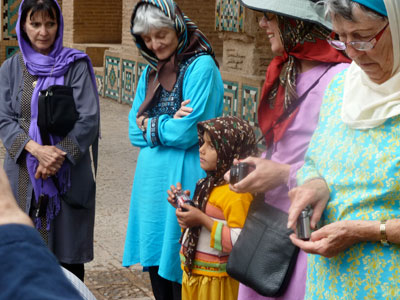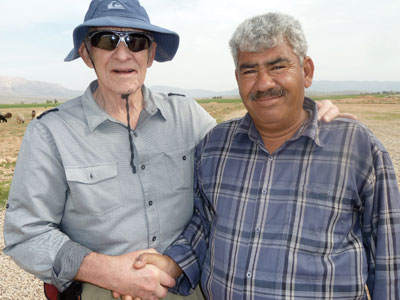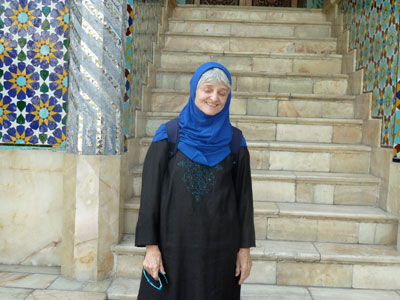Miconceptions of Iran
This item appears on page 26 of the March 2013 issue.
My wife, Bune, and I took the 18-day “Ancient Persia – Modern Iran” trip from MIR Corporation (Seattle, WA; 800/424-7289), April 3-20, 2012. The land price was $5,895 per person, and internal airfare was $150. All meals were included as well as first-class accommodations (or best-available).
When I initially thought about going to Iran, I had several concerns based on misconceptions about the country. I wondered what the people would be like toward us. Bune was worried that demonstrators against America would pose a danger. What if we were kidnapped?
I called several tour companies, including MIR, asking to be put in touch with people who had taken their Iran trips. One woman told me that, while shopping in Iran, she saw a demonstration led by a man burning an American flag. Afterward, the leader came into the store, saw her and asked where she was from. She reluctantly said, “America.” His response was, “Welcome! I love Americans.” She asked why he had burned the flag and he said, “You don’t understand. For leading the demonstration, I got two days off with pay.”
On the tour, I ended up learning that Iranians are friendly and actually like Americans. Today Bune tells everyone what a wonderful trip we had. It lived up to all of my expectations and none of her fears.
Our second misconception was that Iran is a police state and we should expect some harassment. Nothing could have been farther from the truth.
Iran did insist on fingerprinting us before we were allowed through passport control. As far as we could tell, only US citizens were being fingerprinted. We have experienced fingerprinting upon entering a few other countries, so this was not unusual.
We did see police (without weapons) in Imam Square in Isfahan occasionally. We were there at least four times.
While driving from one city to another, we had to stop at checkpoints along the road. The driver told us, through our guide, that he was required to show his driver’s license, bus maintenance logs and a paper that was stamped at each station. It was all due to the fact that there had been too many bus accidents. They checked his speed by noting the time he was checked at the previous station.
Only once did an official (nonuniformed) get on the bus. He stood at the front, looked around, got off the bus and wrote out a ticket to the driver because the passengers were not wearing their seatbelts.
Our third misconception was that Iran was not far from being a Third World country. Wrong! Even in the “hinterlands,” we did not find this to be the case.
After exiting the ruins of a second-century palace, we saw a herdsman with his sheep and goats. Our guide suggested that we talk to him.
The herdsman’s English was flawless. He told us that our country and his were going to settle the nuclear issue in Vienna in the next month. We asked how he knew and he told us he had heard it that morning on TV.
He told us that he had a computer with Internet access and also a cell phone. Seeing no wires around, we asked how he got reception. He said that he had a satellite dish. When I said, “That is illegal in Iran,” he shrugged his shoulders and said, “Ehh. Who cares?” He told us he gets all the major American networks. No wonder so many people we talked to aspired to visit the US or Canada!
From my observation, I think that English is the second language for Iranians. Only in the small villages was I not able to communicate. Many of the signs on stores were in both Farsi and English.
The Iranian infrastructure was up to date. The roads were exceptionally good compared to ours in California (although driving habits were atrocious). The major cities were in the process of building subways. Iranian airports were very modern.
Our fourth misconception was about wearing apparel. It was suggested before our trip that men wear long-sleeved shirts, but I saw men with sleeves of every length. The only tie I saw was on a waiter wearing a tuxedo.
It was suggested that women have their heads covered and show no hair and that they wear loose slacks and loose garments that would cover them from neck to ankle. Bune went prepared to dress that way.
After we arrived, we realized that this requirement had indeed been relaxed. Women were wearing tailored (never leg-hugging) slacks and sometimes head-to-toe chadors, but we also saw form-revealing trench coats, often coming just above the knee (worn, of course, over slacks). Women wore scarves as head coverings, but their hair was certainly showing. My wife quickly replaced her head covering with a scarf and bought a shorter outer garment.
Our last misconception was that, due to the embargos, there would be shortages and a suffering economy. However, at the time, food, clothing, autos, etc., appeared plentiful. We saw no hunger or begging. We were told the inflation rate was 26% and that if someone had money to invest, it went into real estate. Indeed, building cranes were visible in every city.
It was generally better to use the Iranian rial for purchases. Our guides told us to let them take us to money changers, found where there were storefronts with large signs denoting their trade. There were ATMs, but they would take only Iranian cards. The only place we were able to use our credit cards was Isfahan, where we purchased carpets. The carpets were shipped to Dubai and then to us directly via UPS.
The one thing that my wife did not appreciate was the prevalence of Eastern-type squat toilets. This was never a problem in our hotels, but it was in most restaurants and at rest stops along the road. There was no toilet paper, there were no bars to assist one in squatting or rising, and generally the facilities were not particularly clean.
In spite of that, my wife tells one and all to see this unappreciated country. As Iranians we met told us, “Our governments hate each other, but we love Americans.”
I want to mention our national guide, Farzaneh Khademi; she was superlative. We also had an outstanding tour manager, Michel Behar, a Dutchman; he was almost like another guide. In Isfahan, we also had an excellent local guide. The bus drivers were very competent, and the bus was clean and comfortable.
Of the Iran trips we researched, we liked MIR’s itinerary best. In our group, eight of the 14 people had been on a MIR trip before; some had taken as many as six trips with MIR.
MARVIN PRIMACK
Stockton, CA



